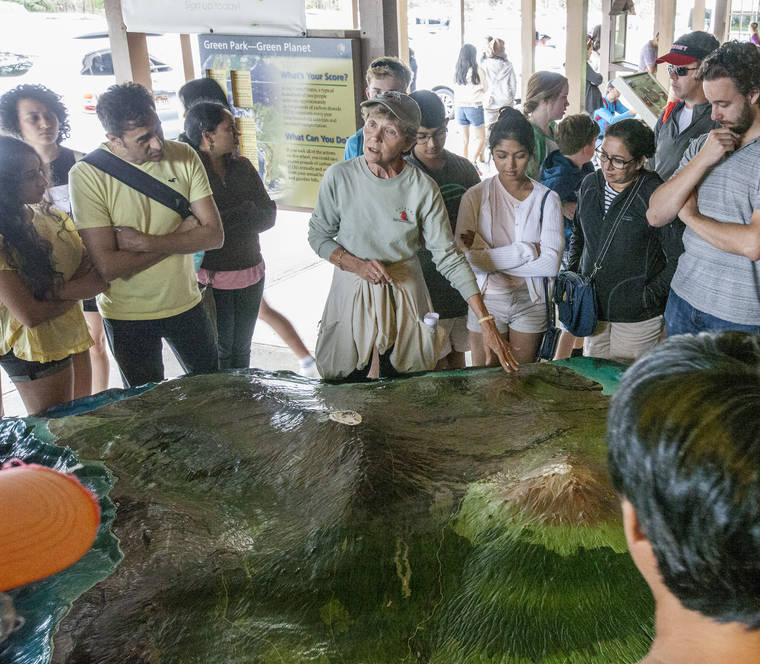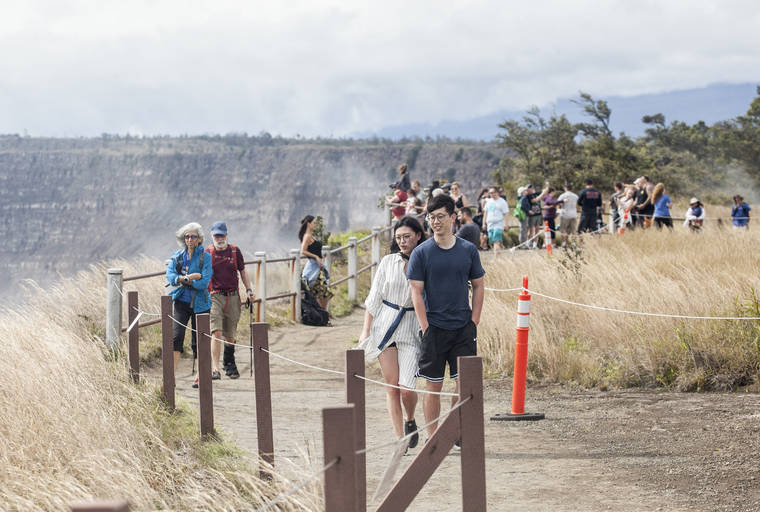HVNP staff working toward fully reopening park
HILO — One year after the Hawaii Volcanoes National Park closed during the Kilauea eruption, several parts of the park have yet to reopen.
To address the current state of the park and its progress toward reopening long-closed areas, the national park held a presentation Thursday titled “Road to Recovery: One Year Later,” inviting the public to learn about the challenges the park still faces.
After a brief chronology describing the events that led to the park’s closure on May 11, 2018 — in particular, the threat of a potentially dangerous steam explosion from the volcano — Jon Christensen, chief of facilities management, discussed the status of the park’s facilities.
“I’m in charge of the built environment,” Christensen said. “Which is pretty much everything that was damaged during the eruption.”
After the constant earthquakes and explosions ended in August, park staff returned to a park that had been ravaged by structural damage and disuse. Beyond the substantial damage to trails, buildings and utilities, grass had grown uncontrolled for months, and mildew had accumulated on surfaces throughout the park, Christensen said.
Despite the widespread damage, and although they were not able to assess all areas of the park, park staff worked hard to reopen the park by Sept. 22, 2018, National Public Lands Day. However, now the park had a new problem, Christensen said: The same staff who needed to work on reopening parts of the park also had to run the day-to-day operations of the park.
That lack of staff is one of the main reasons some parts of the park have been slow to reopen, Christensen said. The crew that assesses the condition of trails is now down to two staff members.
Furthermore, reopening any part of the park requires a thorough study from all manner of disciplines.
“It takes all kinds of ’ologists,” Christensen said.
That said, most of the park has been reopened to some capacity, said park environmental protection specialist Danielle Foster.
Foster provided two lists of park features that remain closed. The first list, of features that need further evaluation, includes Ka‘u Desert Trail, parts of Crater Rim Drive and Trail from Jaggar Museum to Keanakako‘i Crater, Napau Trail and Thurston Lava Tube.
Foster said the lava tube is still awaiting the results of assessments that would determine its safety.
The other list was of park features whose futures are yet to be determined, including Iliahi Trail, parts of Halema‘uma‘u Trail, parts of Crater Rim Drive and Trail, part of Devastation Trail and the area around Jaggar Museum in general.
Foster said there might be an opportunity to open parts of the park around Jaggar in order for visitors to get a closer look at the damage wrought by the thousands of earthquakes during the eruption, but added there are a host of safety considerations to be determined first.
While many of the still-closed features are some of the park’s more popular attractions, Christensen pointed out that the very reason for their popularity — their proximity to Halema‘uma‘u Crater — led them to sustain the most damage.
Although visitor rates to the park have dropped from last year, park director of interpretation Ben Hayes pointed out that Hawaii Volcanoes National Park is unique among national parks in that it undergoes dramatic peaks and valleys in visitorship in correspondence with volcanic activity.
Hayes also said the park is in the process of updating its various visitor publications, including its drive guide and its brochure, which is usually updated only every two years.
“We don’t expect things to change so fast,” Hayes said.
Email Michael Brestovansky at mbrestovansky@hawaiitribune-herald.com.



